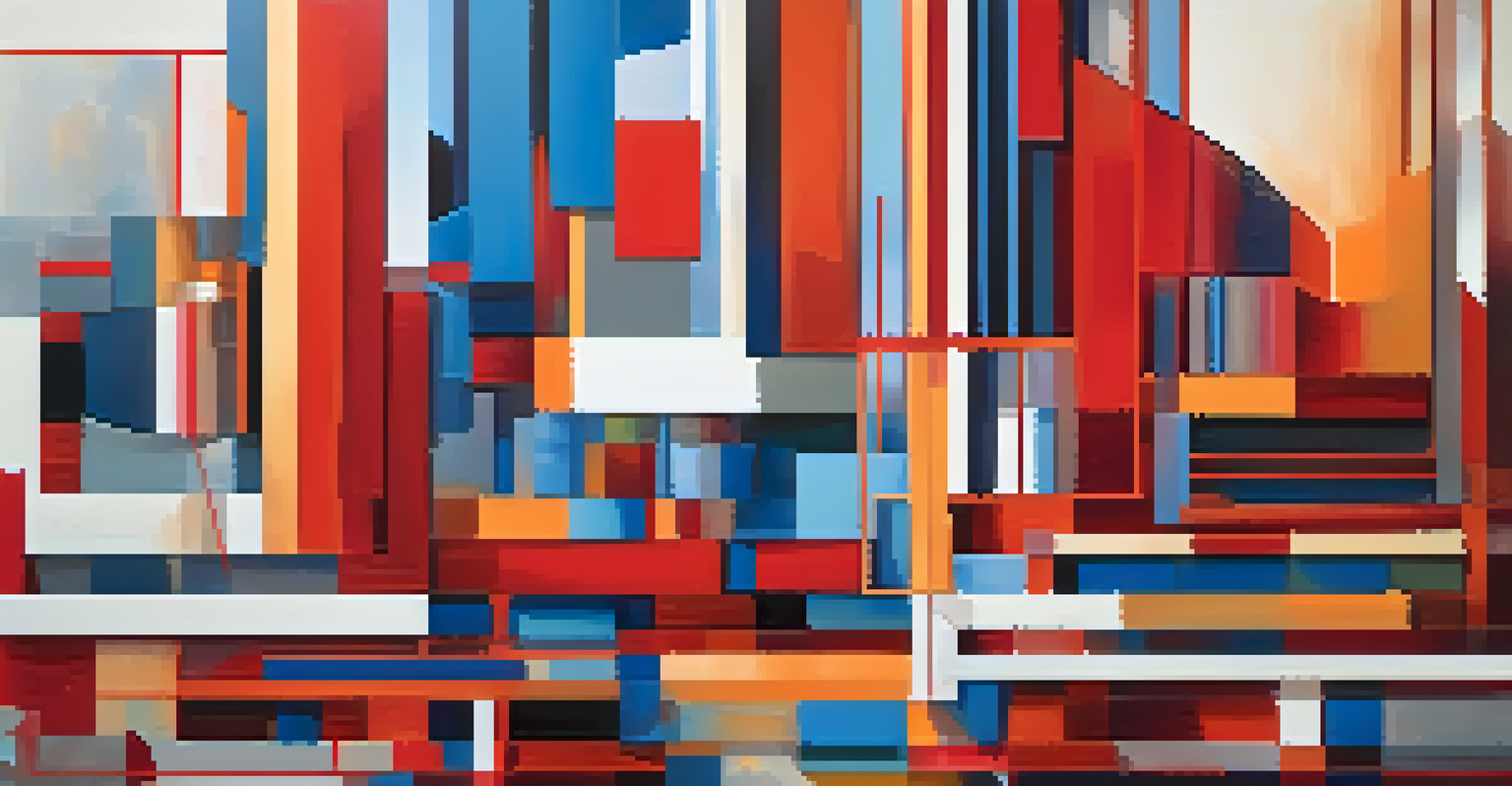Symbolism in Painting: A Window into Cultural Identity

Understanding Symbolism in Art and Its Importance
Symbolism in art serves as a powerful language that communicates deeper meanings beyond the surface. It allows artists to convey complex ideas, emotions, and cultural narratives through visual elements. For example, a simple flower in a painting can represent love, beauty, or even transience, depending on the context and culture.
Art is the most beautiful of all lies; it is a reflection of the truth that is hidden behind the symbols we create.
Artists often use symbols rooted in their cultural backgrounds to express their identities and experiences. This connection between symbolism and culture helps viewers decode the narrative behind the artwork. By understanding these symbols, we gain insight into the artist's intentions and the societal influences that shaped their perspective.
Moreover, symbolism creates a bridge between the artwork and the audience, inviting interpretation and personal connection. Each viewer may resonate with different symbols based on their own cultural backgrounds, making the experience of art both unique and universal.
Historical Context: Symbols Through the Ages
Throughout history, symbolism in painting has evolved, reflecting the zeitgeist of different eras. During the Renaissance, for instance, artists often incorporated religious symbols to convey spiritual narratives and societal values. These symbols were not just decorative; they held significant meaning that resonated with the audience of that time.

As we moved into the Baroque period, the use of symbolism expanded to include themes of power, wealth, and human emotion. Artists like Caravaggio utilized light and shadow as symbolic elements to evoke drama and intensity, illustrating the human experience in a profound way. This evolution in symbolism showcases how art adapts to reflect changing cultural identities.
Symbolism Connects Art and Culture
Symbolism in art enables artists to express complex cultural narratives and emotions, allowing viewers to connect deeply with the artwork.
In modern art, symbolism has taken on new forms, often incorporating abstract concepts that challenge traditional interpretations. Artists like Pablo Picasso used fragmented shapes and colors to symbolize complex emotions, pushing the boundaries of how we understand identity and culture through visual art.
Cultural Identity: A Layered Expression in Art
Cultural identity is intricately woven into the fabric of symbolism in painting. Artists draw from their heritage, traditions, and personal experiences to create works that reflect their unique identities. For example, indigenous artists often incorporate specific motifs that represent their connection to nature and ancestry, creating a dialogue between the past and present.
The painter tries to master the art of symbolism; every color, every brushstroke, tells a story beyond the visible.
This layered expression allows viewers to explore the richness of diverse cultures through the lens of art. By recognizing the symbols related to specific cultures, we can appreciate the nuances of identity that influence the artist's work. It fosters a greater understanding and respect for the cultural narratives that shape our world.
Additionally, cultural identity in art can serve as a form of resistance or empowerment. Artists may use symbolism to challenge stereotypes or highlight social issues, creating powerful statements that resonate with audiences globally. This interplay of art and identity promotes dialogue and encourages empathy across cultural boundaries.
The Role of Nature in Symbolic Representation
Nature often plays a central role in the symbolism found in paintings, representing various aspects of life, growth, and cultural beliefs. Different elements of nature, such as trees, water, and animals, can symbolize everything from fertility and rebirth to tranquility and chaos. For instance, a stormy sea may represent turmoil, while a calm lake could symbolize peace.
Many cultures have specific natural symbols that hold deep meanings, often tied to myths and traditions. In Japanese art, cherry blossoms symbolize the transient nature of life, reflecting the beauty and fragility of existence. Such symbols not only enhance the artwork but also invite contemplation on our relationship with the environment.
Nature as a Universal Symbol
Elements of nature in art symbolize various aspects of life and growth, fostering a universal connection that resonates across different cultures.
Furthermore, the use of nature in symbolism allows artists to connect with universal themes that resonate across cultures. Viewers may find personal significance in these natural symbols, fostering a deeper appreciation for the artwork and its message. This connection underscores the importance of nature as a source of inspiration and identity in painting.
Color Symbolism: Emotions and Cultural Meanings
Colors carry significant symbolic meanings that vary across cultures, adding another layer to the interpretation of paintings. For example, the color red can symbolize love and passion in one culture, while in another, it may represent danger or sacrifice. This diversity in color symbolism highlights how cultural context shapes our understanding of art.
Artists often use color deliberately to evoke specific emotional responses from viewers. A warm palette may create feelings of comfort and joy, while cool hues could evoke calmness or sadness. This emotional aspect of color symbolism enhances the viewer's connection to the artwork, making the experience more immersive.
Moreover, understanding color symbolism can deepen our appreciation for the artist's choices and intentions. By recognizing the cultural meanings behind colors, we can engage with the artwork on a more profound level, uncovering the layers of emotion and identity embedded within.
Symbols of Resistance: Art as a Political Tool
Throughout history, artists have used symbolism as a means of resistance against political oppression and social injustice. Art becomes a powerful tool for expressing dissent and advocating for change, often employing symbols that resonate with collective struggles. For example, the raised fist is a universal symbol of solidarity and resistance against oppression.
By integrating these symbols into their work, artists can communicate messages that challenge the status quo, encouraging viewers to reflect on societal issues. This form of artistic expression not only raises awareness but also fosters a sense of community among those who share similar experiences and aspirations.
Art as a Tool for Resistance
Artists have historically used symbolism to challenge societal norms and advocate for social change, transforming art into a powerful vehicle for political expression.
In contemporary art, we see a resurgence of this symbolic resistance, with artists using their platforms to address urgent social issues like climate change, racial inequality, and human rights. Through their work, they inspire dialogue and action, proving that art can be a catalyst for social change while reflecting the cultural identities of those involved.
The Future of Symbolism in Art and Cultural Identity
As we look to the future, symbolism in painting continues to evolve, reflecting the complexities of modern cultural identities. Globalization and technological advancements have opened new avenues for artists to express their identities and draw from diverse influences. This fusion often leads to innovative uses of symbolism that challenge traditional norms.
Emerging artists are experimenting with new mediums and styles, incorporating contemporary symbols that resonate with current societal issues. The rise of digital art, for instance, allows for a broader exploration of symbolism, enabling artists to reach wider audiences and engage in global conversations about identity and culture.

Ultimately, the future of symbolism in art remains intertwined with cultural identity, as artists navigate an ever-changing landscape. By embracing the rich tapestry of influences and experiences, symbolism in painting will continue to serve as a powerful lens through which we can understand ourselves and each other in an increasingly interconnected world.